I’ve been back in the United States for a month now. Adjusting to the eight-hour time difference and sixty-degree temperature change in the midst of Christmas celebrations was a bit difficult. But it was certainly nice to arrive at a time when family and friends were gathering together and wide varieties of food were both abundant and delectable.
As nice as it is to have certain amenities once again, such as hot showers, temperature controlled houses, and flushing toilets, these things feel almost like luxuries now, and I would trade these comforts for more time in Madagascar in a heartbeat. I have not stopped thinking about the people and wildlife of Madagascar and am eager to return one day. Although I miss the country so much, it is time for me to refocus and put all my energy into my next experience (which I will begin writing about in the next few weeks). But first, since I was unable to post any blogs during my last few weeks in Madagascar due to spotty connection, it is time for a short recap.
Being very disconnected to the outside world, with the eight-hour time difference and slow internet connection, had huge perks over the three-month trip. Throughout each week, I had time to study for the GRE (although not the most fun things to do in Madagascar), read books and scientific journal articles, keep a daily journal, write blog posts, and learn as much Malagasy as I could.
The weekends were either spent synthesizing and entering data for our bi-weekly reports, or traveling. The plague epidemic made travel more difficult so we were encouraged to spend the extra money required to rent a minivan and driver for our trips. The only other alternative was the cheap, but overcrowded taxi brousses that had contributed to the spread of the plague. Nevertheless, we traveled as much as possible.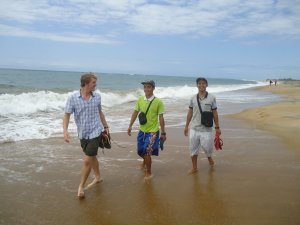
Our first weekend trip was to Manajary, a little town on the coast of the Indian ocean about an hour and a half away. We spent our days wandering around the village, trying various street foods, shopping for souvenirs, perusing the market for fresh fruit, wandering down the beach and dipping our feet in the Indian Ocean. At night, we played cards and went to the karaoke bar down the street. We even saw Dadi Love, one of the famous Malagasy bands, arriving to eat at the same small restaurant where we were eating a very American meal of pizza and ice cream.
Our second weekend trip was to Ranomafana National Park, just two hours farther west into the mountains. We saw the famous Golden Bamboo lemurs for which the park was created, as well as the last two Greater Bamboo lemurs left in the park (a father and 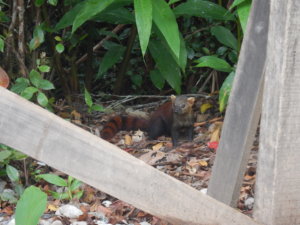 daughter), a group of Red Bellied Brown Lemurs with a few babies, a pair of Black and White Ruffed lemurs with two babies, and a group of Red Fronted Brown lemurs with several babies. We also happened upon some of the unique creatures that Madagascar is known for, such as the giraffe weevil, the ring tailed mongoose, a couple of streaked tenrecs, and a satanic leaf-tailed gecko. The park truly felt like a rainforest, damp and blanketed by heavy fogs, and made us reflect on how Kianjavato would have felt 30 years ago when there was continuous rainforest stretching from Ranomafana to Kianjavato.
daughter), a group of Red Bellied Brown Lemurs with a few babies, a pair of Black and White Ruffed lemurs with two babies, and a group of Red Fronted Brown lemurs with several babies. We also happened upon some of the unique creatures that Madagascar is known for, such as the giraffe weevil, the ring tailed mongoose, a couple of streaked tenrecs, and a satanic leaf-tailed gecko. The park truly felt like a rainforest, damp and blanketed by heavy fogs, and made us reflect on how Kianjavato would have felt 30 years ago when there was continuous rainforest stretching from Ranomafana to Kianjavato.
Our third trip was to Anja Community Reserve, a six hour drive from Kianjavato. When we arrived, we were almost immediately surrounded by ring tailed lemurs. They were in the trees, on the ground, sunbathing on rocks, and leaping less than a foot away from us on their predetermined paths. The hundreds of lemurs in the park 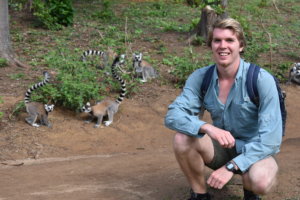 were completely indifferent to us, as it should be with well-habituated lemurs. This, of course, made for incredible photo opportunities and made us feel like true tourists. We also made the slightly regretful decision to hike the mountain towering above the reserve. The mountain was almost entirely composed of continuous rock, and our guide, with bare feet, sidled up the mountain with the ease of a mountain goat. We barely had ten minutes at the summit before our guide became anxious at the rain clouds quickly moving toward us so we were forced to hurry down the backside of the mountain after him. We didn’t even have much time to wonder why we hadn’t gone up this way, a much easier path, before the rain was upon us. The next morning, we were able to spend a few more hours with sunbathing lemurs before embarking on the six-hour drive back to Kianjavato.
were completely indifferent to us, as it should be with well-habituated lemurs. This, of course, made for incredible photo opportunities and made us feel like true tourists. We also made the slightly regretful decision to hike the mountain towering above the reserve. The mountain was almost entirely composed of continuous rock, and our guide, with bare feet, sidled up the mountain with the ease of a mountain goat. We barely had ten minutes at the summit before our guide became anxious at the rain clouds quickly moving toward us so we were forced to hurry down the backside of the mountain after him. We didn’t even have much time to wonder why we hadn’t gone up this way, a much easier path, before the rain was upon us. The next morning, we were able to spend a few more hours with sunbathing lemurs before embarking on the six-hour drive back to Kianjavato.
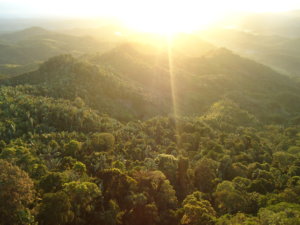 A couple of our reporting weekends were even spiced up with some excursions to the highest peaks of Sangasanga and Vatovavy (our two study sites). We woke up at 3:30am for the Sangasanga hike, so we could see the sunrise. There could not have been a better way to start a Sunday morning than seeing the first light of day set the rivers and rainforests below us ablaze with color. Vatovavy was a longer and more challenging hike, so a sunrise hike was not a consideration, but we still started early to beat the heat. We saw and heard several groups of lemurs as we were hiking up, and were rewarded with a 360 view. The Indian Ocean could be seen in the distance, and our Malagasy friends pointed out Mananjary, and the mountains that lead to Ranomafana.
A couple of our reporting weekends were even spiced up with some excursions to the highest peaks of Sangasanga and Vatovavy (our two study sites). We woke up at 3:30am for the Sangasanga hike, so we could see the sunrise. There could not have been a better way to start a Sunday morning than seeing the first light of day set the rivers and rainforests below us ablaze with color. Vatovavy was a longer and more challenging hike, so a sunrise hike was not a consideration, but we still started early to beat the heat. We saw and heard several groups of lemurs as we were hiking up, and were rewarded with a 360 view. The Indian Ocean could be seen in the distance, and our Malagasy friends pointed out Mananjary, and the mountains that lead to Ranomafana.
These trips could not have been possible 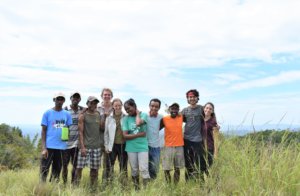 without the help of Fredo, the field station manager, and the Malagasy graduate students at the field station. They were always so gracious in helping us arrange rental cars, joining us on trips and hikes to watch out for us, and translating for us when needed. Our time in Madagascar was so much more because of them and they all became our close friends.
without the help of Fredo, the field station manager, and the Malagasy graduate students at the field station. They were always so gracious in helping us arrange rental cars, joining us on trips and hikes to watch out for us, and translating for us when needed. Our time in Madagascar was so much more because of them and they all became our close friends.
Saying goodbye to them was so difficult, and our last week was full of farewells; we said Veloma (goodbye) to our field guides who we had spent almost every day with for the past 10 weeks, to the reforestation workers we had come to know, and to our English students who we had spent every Monday and Wednesday night working with.
Our last adventure in Madagascar was actually a last-minute decision to see Indri (the largest extant species of lemur) before we left the country. Mine was the first flight out of the country, so it was a race to see this species. We arrived in the capitol on a Saturday night, left the next morning to drive four hours to Andasibe, spent the remainder 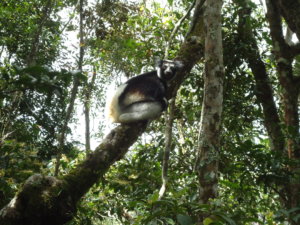 of Sunday as well as a couple hours Monday morning in the forest with Indri, and drove the four hours back to the Capitol to pick up my luggage and drive another hour to the airport to make my 5:00 flight on Monday. Every road block or traffic delay on our way back to the capitol raised my stress level, but I made it to the airport and caught my flight with a half hour to spare. Any rise in blood pressure was well worth it, however, because the Indri were awe-inspiring. Their large bodies reminded us of gibbons. But their piercing vocalizations, loud as a siren, have almost no comparison except for the calls of humpback whales. The forests echoed with groups of Indri responding to one another. And standing in the forest, listening to what is known by locals as the song of the forest, was a surreal experience.
of Sunday as well as a couple hours Monday morning in the forest with Indri, and drove the four hours back to the Capitol to pick up my luggage and drive another hour to the airport to make my 5:00 flight on Monday. Every road block or traffic delay on our way back to the capitol raised my stress level, but I made it to the airport and caught my flight with a half hour to spare. Any rise in blood pressure was well worth it, however, because the Indri were awe-inspiring. Their large bodies reminded us of gibbons. But their piercing vocalizations, loud as a siren, have almost no comparison except for the calls of humpback whales. The forests echoed with groups of Indri responding to one another. And standing in the forest, listening to what is known by locals as the song of the forest, was a surreal experience.
When it came time to leave the country, I did not feel ready to part ways with the island of lemurs. But the memories and friendships will never leave my heart and mind. And I know that I did not say Veloma (goodbye) to Madagascar forever. I will return.


Thank you for sharing, Christopher. Beautifully written.